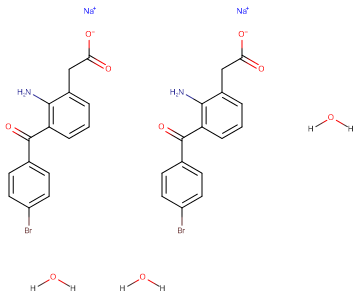
Bromfenac sodium
CAS No. 120638-55-3
Bromfenac sodium( Bromfenac Sodium Sesquihydrate | AHR 10282B )
Catalog No. M10754 CAS No. 120638-55-3
Bromfenac Sodium is the sodium salt form of bromfenac, a nonsteroidal anti-inflammatory drug (NSAID) with analgesic and anti-inflammatory activities.
Purity : >98% (HPLC)
 COA
COA
 Datasheet
Datasheet
 HNMR
HNMR
 HPLC
HPLC
 MSDS
MSDS
 Handing Instructions
Handing Instructions
| Size | Price / USD | Stock | Quantity |
| 10MG | 42 | Get Quote |


|
| 25MG | 61 | Get Quote |


|
| 50MG | 88 | Get Quote |


|
| 100MG | 146 | Get Quote |


|
| 200MG | 227 | Get Quote |


|
| 500MG | 408 | Get Quote |


|
| 1G | Get Quote | Get Quote |


|
Biological Information
-
Product NameBromfenac sodium
-
NoteResearch use only, not for human use.
-
Brief DescriptionBromfenac Sodium is the sodium salt form of bromfenac, a nonsteroidal anti-inflammatory drug (NSAID) with analgesic and anti-inflammatory activities.
-
DescriptionBromfenac Sodium is the sodium salt form of bromfenac, a nonsteroidal anti-inflammatory drug (NSAID) with analgesic and anti-inflammatory activities. Upon ophthalmic administration, bromfenac binds to and inhibits the activity of cyclooxygenase II (COX II), an enzyme which converts arachidonic acid to cyclic endoperoxides, precursors of prostaglandins (PG). By inhibiting PG formation, bromfenac is able to inhibit PG-induced inflammation, thereby preventing vasodilation, leukocytosis, disruption of the blood-aqueous humor barrier, an increase in vascular permeability and an increase in intraocular pressure (IOP).(In Vitro):Bromfenac (0-80 μg/mL; 24 h) can inhibit transforming growth factor-β2-induced epithelial-mesenchymal transition in HLEC-B3 in a concentration-dependent manner.Bromfenac (80 μg/Ml; 48 h) inhibits transforming growth factor-β2-induced epithelial-mesenchymal transition in human anterior capsules.(In Vivo):Bromfenac (0.0032-3.16%; 100 or 200 μL; rubbed onto the backs) produces significant anti-inflammatory activity at concentrations as low as 0.1% (4 h pretreatment time) or 0.32% (18h pretreatment time) in rats.Bromfenac (0.032-3.16%; 100 μL; rubbed onto the paws) produces dose-related anti-inflammatory activity in rats.Bromfenac (0.032-1.0%; 50 μL) is 26 times more potent than indomethacin in blocking the erythema when applied directly onto the skin area exposed to UV light in guinea pigs.Bromfenac (0.0032-0.1%; 50μL; rubbed onto the uninjected paw for 4 h per day and 5 days per week) produces a dose and time dependent reduction in the paw volume of both hind limbs in rats.Bromfenac (0.32%; 50μL; rubbed onto the abdomen) produces significant blockade of abdominal constriction to ACh challenge in mice.Bromfenac (eyedrop instillation; 1 μL (0.09%) per eye; twice-daily; 4 w) partially reduces corneal staining, and becomes so more slowly by the 4-week time point.
-
In VitroBromfenac (0-80 μg/mL; 24 h) can inhibit transforming growth factor-β2-induced epithelial-mesenchymal transition in HLEC-B3 in a concentration-dependent manner.Bromfenac (80 μg/Ml; 48 h) inhibits transforming growth factor-β2-induced epithelial-mesenchymal transition in human anterior capsules. Cell Viability Assay Cell Line:Transforming growth factor-β2-treated human anterior capsules Concentration:80 μg/mL Incubation Time:48 hoursResult:Suppressed transforming growth factor-β2-induced epithelial-mesenchymal transition in primary LECs.Cell Migration Assay Cell Line:HLEC-B3 cells Concentration:0, 20, 40, 60, and 80 μg/mL Incubation Time:24 hours Result:Suppressed transforming growth factor-β2-induced cell migration in HLEC-B3 cells, and exhibited inhibition of the over-expression of epithelial-mesenchymal transition markers.
-
In VivoBromfenac (0.0032-3.16%; 100 or 200 μL; rubbed onto the backs) produces significant anti-inflammatory activity at concentrations as low as 0.1% (4 h pretreatment time) or 0.32% (18h pretreatment time) in rats.Bromfenac (0.032-3.16%; 100 μL; rubbed onto the paws) produces dose-related anti-inflammatory activity in rats.Bromfenac (0.032-1.0%; 50 μL) is 26 times more potent than indomethacin in blocking the erythema when applied directly onto the skin area exposed to UV light in guinea pigs.Bromfenac (0.0032-0.1%; 50μL; rubbed onto the uninjected paw for 4 h per day and 5 days per week) produces a dose and time dependent reduction in the paw volume of both hind limbs in rats.Bromfenac (0.32%; 50μL; rubbed onto the abdomen) produces significant blockade of abdominal constriction to ACh challenge in mice.Bromfenac (eyedrop instillation; 1 μL (0.09%) per eye; twice-daily; 4 w) partially reduces corneal staining, and becomes so more slowly by the 4-week time point. Animal Model:Male Sprague-Dawley rats (150-250 g) are injected carrageenan Dosage:0.0032, 0.01, 0.032, 0.1, 0.32, 1.0, 3.16% (100 or 200 μL) Administration:Rubbed onto the backs before 1-72 h of injected carrageenan Result:Produced significant anti-inflammatory activity when applied 1, 2, and 4 h prior to carrageenan challenge at 0.32%.Applied 1 or 4 h prior to carrageenan challenge was active, but not when applied 24 h (or longer) prior to challenge at 0.2%.Animal Model:Male injected with Salin or BTX-B Dosage:1 μL (0.09%) per eye Administration:Eyedrop instillation; 1 μL (0.09%) per eye; twice-daily; 4 weeks Result:Improved the corneal fluorescein staining score later at 4 weeks after treatment.
-
SynonymsBromfenac Sodium Sesquihydrate | AHR 10282B
-
PathwayChromatin/Epigenetic
-
TargetCOX
-
RecptorCOX-2
-
Research AreaInflammation/Immunology
-
Indication——
Chemical Information
-
CAS Number120638-55-3
-
Formula Weight356.15
-
Molecular FormulaC15H11BrNNaO3
-
Purity>98% (HPLC)
-
SolubilityDMSO: 10 mM
-
SMILESO=C([O-])CC1=CC=CC(C(C2=CC=C(Br)C=C2)=O)=C1N.O=C([O-])CC3=CC=CC(C(C4=CC=C(Br)C=C4)=O)=C3N.[H]O[H].[H]O[H].[H]O[H].[Na+].[Na+]
-
Chemical NameDisodium 2-[2-amino-3-(4-bromobenzoyl)phenyl]acetate trihydrate
Shipping & Storage Information
-
Storage(-20℃)
-
ShippingWith Ice Pack
-
Stability≥ 2 years
Reference
1.Shimura M, Yasuda K. Br J Ophthalmol. 2015 Feb;99(2):215-9.
molnova catalog



related products
-
Zaltoprofen
Zaltoprofen is an inhibitor of Cox-1 and Cox-2 for treatment of arthritis.
-
Indometacin
Indomethacin is a non-steroidal antiinflammatory agent (NSAIA) with antiinflammatory, analgesic and antipyretic activity.
-
Phenetidine
Used in the manufacture of acetophenetidin.



 Cart
Cart
 sales@molnova.com
sales@molnova.com


